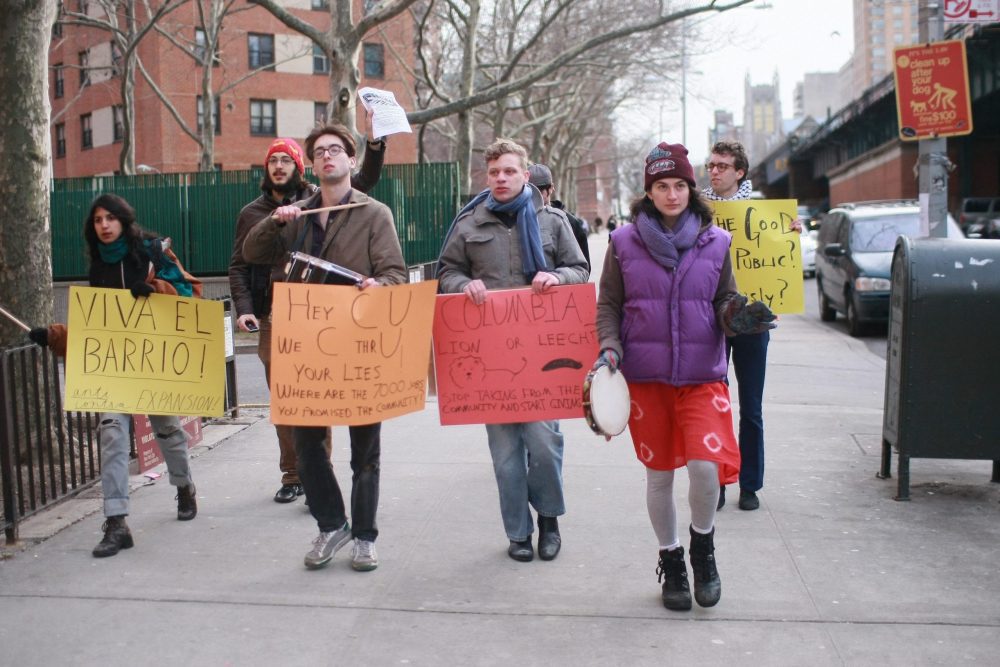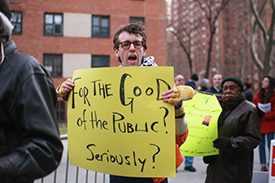
Columbia University’s expansion into West Harlem was expected to bring thousands of jobs to the community. In 2011, local residents and students called on the university to provide what had been promised in a community benefits agreement. Photo by Andra Mihali, via flickr, CC-BY-SA 2.0
In 2005, Columbia University announced a $6.3 billion plan to expand its campus into 17 acres of West Harlem known as Manhattanville. Residents had many concerns about the university’s years-long project and its control of significant property in a community increasingly facing displacement and increasing income disparity. While opponents were unable to prevent the expansion or change it in the ways they had hoped, by 2009, the community was successful in securing a community benefits agreement (CBA) with the university.
CBAs are contractual agreements between represented community groups and developers that detail specific benefits a developer will provide to the community in exchange for public support of the proposed project. Common examples include changing elements of the project itself based on community feedback, dedicating a percentage of jobs and contracts to residents or other stakeholders, and funding projects such as affordable housing, public space, or youth programming.
Columbia signed the West Harlem Community Benefits Agreement in 2009 with the West Harlem Local Development Corporation (WHLDC), earmarking a whopping $150 million commitment in the form of funding and in-kind donations to proactively address certain critical community needs as a condition of the university’s expansion. WHLDC, composed of local community members, was established by Manhattan’s Community District 9 to engage in negotiations with the university on behalf of the West Harlem community and it was tasked with managing and distributing the funds Columbia agreed to provide.
The CBA made Columbia responsible for funding four major projects: a $76 million benefits fund to be paid out in installments via WHLDC over the course of 16 years to address workforce development, education, historic preservation, the arts, and community facilities; a $20 million affordable housing fund also administered by WHLDC, with $4 million in related legal expenses; $30 million to build the K-5 public Teachers College Community School, which opened in 2011; and $20 million worth of in-kind services such as access for residents to the university’s facilities, services, and amenities over the course of 25 years.
For its first three years, WHLDC lacked a mission statement, formal procedures and policies, staff, or even a work place, according to an investigation by the New York attorney general’s office (which also found it had done nothing illegal). In those first three years it issued only one $300,000 grant from the benefits fund and spent only $345,000 of the affordable housing fund, but it spent $400,000 on politically connected consulting services. After the investigation, WHLDC restructured itself as a nonprofit organization called the West Harlem Development Corporation (WHDC) between 2011 and 2013.
The group has since worked to turn things around, providing greater transparency of its fiscal practices and documenting the dissemination of over $4 million to more than 120 nonprofits in and around the Manhattanville community to date (though to disburse $76 million over 16 years it should have been averaging $4.75 million every year).
In the years following the agreement, the relationship between the community and the university has remained contentious, and some residents and policymakers have publicly expressed their discontent over both the scope and size of the original CBA and the speed, focus, and objectivity of its implementation by WHDC. Some attorneys and community leaders say the original CBA lacked clear and legally enforceable language, and are concerned that if the community does not end up benefiting, there will be no legal options to ensure compliance.
Whether Columbia intends to fully meet the relatively ambiguous obligations outlined in the original CBA, and whether WHDC will turn those funds into results for the community, one thing is certain: The Columbia Manhattanville CBA is a good example of how a community benefits agreement can be extremely difficult to implement and enforce.
A Major Deal
The first major execution of a CBA deal took place in 2001 with the negotiation of the development of the sports and entertainment district surrounding the Staples Center arena in Los Angeles. Community group Figueroa Corridor Coalition for Economic Justice served at the helm of negotiations, trading its support for the development of a multipurpose hotel, theater, convention center expansion, and housing complex (and the more than $70 million in subsidies it got from the city) for commitments including job-training programs, permanent employment for local residents with 70 percent of jobs paying the city’s living wage, $1 million toward a public park, and 500 affordable housing units. Since completion of the development and these requirements, the developer has remained committed to working with local jobs coalitions, providing ongoing job training, and opportunities.
The project continues to serve as a model for how community coalitions can win an array of nuanced social and economic benefits for their communities through CBAs. Los Angeles activists have followed up with a strong CBA related to the $11 billion redevelopment of the Los Angeles airport, and they are looking toward the $1 billion redevelopment of the Los Angeles River as well. What separates the Staples Center from Manhattanville?
Lines of Demarcation
In her 2010 paper, “Community Benefits Agreements: A New Local Government Tool or Another Variation on the Exactions Theme,” Vicki Been, now New York City’s housing commissioner and director and law professor at the Furman Center for Real Estate and Urban Policy at New York University, outlines several flaws in the design of many well-intended community benefits agreements.
According to Been, the first challenge is representation. People participating in CBA negotiations as a “community member” may not represent the best interests of the community. Because they are not officially elected, there is no guarantee of transparency or accountability in the process of establishing and executing the CBA.
Been also considers that even accountable representatives of a coalition may not have the needed skills or experience to negotiate contracts appropriately or strongly on behalf of the community.
Where enforcement is concerned, Been writes CBA negotiations between developers and municipalities can be enforced through exactions and impact fees that ensure developers bear the costs and risks of development, use public subsidies efficiently, and mitigate unforeseen impacts of development.
Community groups, on the other hand, have very few protections when a developer breaches a mutually agreed-upon CBA. Even if a contract meets appropriate legal standards, Been notes, “there are no federal or state cases yet squarely addressing legal issues involving the enforcement of CBAs,” thus community groups’ ability to remedy a breach of contract from a legal standpoint remains unclear.
Crafting Clarity
Community groups seeking to craft enforceable CBAs need to start with a quality, detailed agreement in the early stages of the community-developer relationship.
Ben Beach, legal director for Partnership for Working Families (PWF), says that compliance issues are often the result of poorly crafted agreements that are too aspirational in nature. Often, he explains, they contain non-specific language that is bereft of deadlines and contains loopholes that allow developers to give cash to community projects in lieu of specific benefits.
Since 2001, PWF has worked with community groups across the country to develop and execute a significant number of successful CBAs. A 2012 University of Chicago article estimates that approximately 50 CBAs have been negotiated between community coalitions and developers since the Los Angeles Staples Center neighborhood model, with an estimated 28 projects in effect today.
“While most CBAs are clearly and easily enforceable, unfortunately some CBAs are designed to be hard to enforce,” Beach says. “Some contain terms that are not specific or concrete, while others contain limitations on community enforcement. A few don’t have community parties at all—they’re just between government entities and the developers.” The Partnership has published a guide to helping avoid these pitfalls.
To help improve outcomes, Beach recommends that community coalitions craft CBAs to explicitly permit courts to award “specific performance,” requiring a party that has not met its obligations to take certain actions to make things right.
Beach also says the initial CBA contract should contain “liquidated damages” clauses that specify an amount of money the parties agree must be paid in the event that particular obligations are not met.
“Coalitions should be prepared to be heavily involved in the monitoring and enforcement process,” Beach explains. “Or to elect a formal monitoring committee that includes community members and governmental agencies engaged in ensuring that the obligations under the CBA are being met.”
Beach says there may also be political or business consequences for developers who make promises to communities and the broader public in order to gain support for their project and then fail to make good on those promises. A public entity that is a party to a CBA may, for example, bar willfully noncompliant businesses from bidding on public contracts issued by that entity.
In all, Beach says measures typically contained in CBAs, such as those related to local hiring or living wage, require close attention. Although it requires more work on the front end, paying close attention means a greater likelihood of catching and correcting problems early and avoiding big disappointments and disputes down the road.
Future-Proofing Equity
Coalitions are becoming much more savvy in their pursuit of CBAs by sharing knowledge and best practices in the field.
For example, a CBA conference held in Chicago in April 2016 aimed to spark citywide discussions on best practices for the development and enforcement of the community tool. Over 30 Chicago-based nonprofits, 7 community coalitions seeking benefit agreements with developers in their respective communities, and several public officials were in attendance.
Amalia Nieto Gomez, executive director of the Alliance of the Southeast (ASE) who helped organize the conference, recounts a question about how coalition groups can ensure developer compliance to a CBA by implementing strategic monitoring plans.
ASE is one of several community groups working with the Coalition for a Lakeside CBA on negotiating the development of the 600-acre U.S. Steel Southworks site. The site is the last undeveloped lakefront property in Chicago and one of the largest developments in the region. Since the conference, the property has been put back on the market by U.S. Steel, which abandoned a proposed $4 billion development plan earlier this year in favor of splitting the property into four parcels for individual sale.
Prior to the pivot in development strategy, the city and county committed to providing the development project with 10 years of tax abatements, over a half a billion dollars in tax increment financing, and other bonds and funds.
In its initial draft of a CBA, the Coalition for a Lakeside CBA outlined concessions such as living-wage jobs granted to a large number of residents, job training for residents in partnership with local schools, the development of affordable housing units made available to current area residents, tax-relief for long-term residents via deed restrictions, and a strong focus on environmental sustainability to mitigate increased traffic pollution and other environmental consequences of the added density.
Their enforcement plan for the proposed CBA will include the creation of a community board, which will oversee compliance throughout the duration of the project and report on outcomes of its goals, Nieto Gomez explained.
The coalition’s early start on establishing checks and balances to ensure compliance with its desired development outcomes put it ahead of the game.
John Goldstein, a civic engagement consultant and a former campaign director at Partnership for Working Families, says groups must be in front of the project-planning cycle to be successful. Having helped organize and counsel grassroots efforts in Milwaukee, Pittsburgh, Buffalo, Detroit, and other cities, Goldstein agrees that in addition to a clear and well-written CBA, a mobilized community coalition that makes it difficult for developers to walk away from the agreement is crucial to enforcement.
Equipping the Elected
Public-sector involvement can also increase the likelihood that community benefits actually materialize. Government officials tied closely to both community groups and development projects are in a unique position to ensure the enforcement of CBAs.
In Delivering Community Benefits Through Economic Development: A Guide For Elected and Appointed Officials, PWF suggests that local leaders look to several strategies to ensure enforcement of community benefits, including establishing baseline laws or policies requiring that developers provide local hiring and contracting, living wages, or affordable housing across all projects that meet certain criteria. Similarly, city governments can enact ordinances, zoning codes, regulatory incentives, tax abatements, and other methods to promote across-the-board community benefits for residents. They can also require impact reports to demonstrate the value of a proposed project.
Driving Collaborative Inclusion and Accountability
One of the most recent and notable CBA deals is the $800 million Oakland Army Base redevelopment project. In 2012 developers, community coalitions, government officials, and unions came together on the city’s largest redevelopment in decades to create a pathway of economic opportunity for Oakland’s most vulnerable residents—those with longtime unemployment, low skills, and criminal-justice system records.
Community groups like the East Bay Alliance for a Sustainable Economy, the Alliance of Californians for Community Empowerment, Oakland Rising, and Revive Oakland engaged residents to support the local-hiring provisions. In exchange for public support from coalition members, the developers, who received over $300 million in public resources for the project, promised permanent jobs for local residents who had various barriers to employment, apprenticeship programs, a job resource center, and a public park.
The Oakland Army Base project, which broke ground in 2013, is anticipated to produce more than 2,800 construction jobs and 2,000 long-term operations jobs over its first seven years. A compliance oversight committee made up of members of the community and public entities reviews monthly compliance reports on the project, and so far the news has been good. A reported 500 new hires from the local community currently work at the site, which is slated to be developed as an international trade and logistics center at the Port of Oakland. Thus far, city compliance reports reveal that the project is exceeding expectations in delivering on its benefits agreement. Over 50 percent of workforce apprentice hours have gone to community residents who were veterans, had past convictions, or had been unemployed—double what was required in the agreement.





Comments